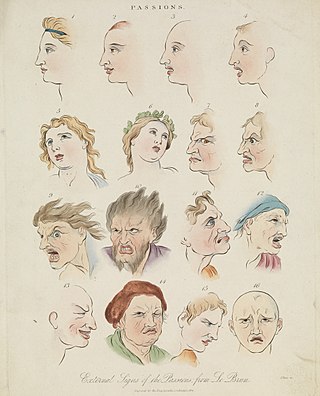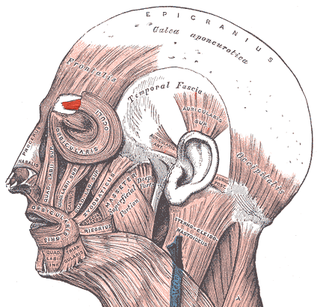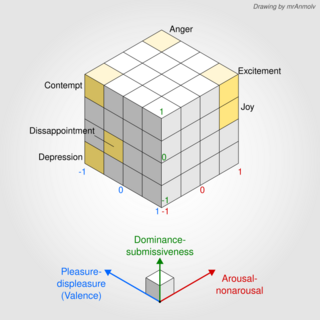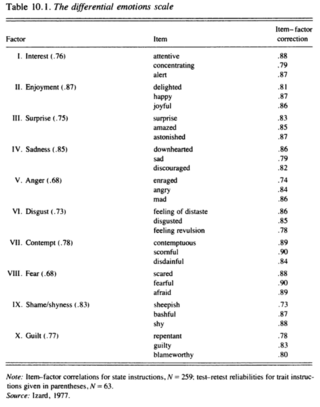Psychophysiology is the branch of psychology that is concerned with the physiological bases of psychological processes. While psychophysiology was a general broad field of research in the 1960s and 1970s, it has now become quite specialized, based on methods, topic of studies and scientific traditions. Methods vary as combinations of electrophysiological methods, neuroimaging, and neurochemistry. Topics have branched into subspecializations such as social, sport, cognitive, cardiovascular, clinical and other branches of psychophysiology.

Affective neuroscience is the study of how the brain processes emotions. This field combines neuroscience with the psychological study of personality, emotion, and mood. The basis of emotions and what emotions are remains an issue of debate within the field of affective neuroscience.

Affective science is the scientific study of emotion or affect. This includes the study of emotion elicitation, emotional experience and the recognition of emotions in others. Of particular relevance are the nature of feeling, mood, emotionally-driven behaviour, decision-making, attention and self-regulation, as well as the underlying physiology and neuroscience of the emotions.

Affect, in psychology, refers to the underlying experience of feeling, emotion, attachment, or mood.
Affect displays are the verbal and non-verbal displays of affect (emotion). These displays can be through facial expressions, gestures and body language, volume and tone of voice, laughing, crying, etc. Affect displays can be altered or faked so one may appear one way, when they feel another. Affect can be conscious or non-conscious and can be discreet or obvious. The display of positive emotions, such as smiling, laughing, etc., is termed "positive affect", while the displays of more negative emotions, such as crying and tense gestures, is respectively termed "negative affect".

Frisson, also known as aesthetic chills or psychogenic shivers, is a psychophysiological response to rewarding stimuli that often induces a pleasurable or otherwise positively-valenced affective state and transient paresthesia, sometimes along with piloerection and mydriasis . The sensation commonly occurs as a mildly to moderately pleasurable emotional response to music with skin tingling; piloerection and pupil dilation not necessarily occurring in all cases.

Emotion classification, the means by which one may distinguish or contrast one emotion from another, is a contested issue in emotion research and in affective science. Researchers have approached the classification of emotions from one of two fundamental viewpoints:
- that emotions are discrete and fundamentally different constructs
- that emotions can be characterized on a dimensional basis in groupings
Affect consciousness refers to an individual's ability to consciously perceive, tolerate, reflect upon, and express affects. These four abilities are operationalized as degrees of awareness, tolerance, emotional (nonverbal) expression, and conceptual (verbal) expression of each of the following eleven affect categories:
Emotional responsivity is the ability to acknowledge an affective stimuli by exhibiting emotion. It is a sharp change of emotion according to a person's emotional state. Increased emotional responsivity refers to demonstrating more response to a stimulus. Reduced emotional responsivity refers to demonstrating less response to a stimulus. Any response exhibited after exposure to the stimulus, whether it is appropriate or not, would be considered as an emotional response. Although emotional responsivity applies to nonclinical populations, it is more typically associated with individuals with schizophrenia and autism.
Emotion can have a powerful effect on humans and animals. Numerous studies have shown that the most vivid autobiographical memories tend to be of emotional events, which are likely to be recalled more often and with more clarity and detail than neutral events.
Affect measures are used in the study of human affect, and refer to measures obtained from self-report studies asking participants to quantify their current feelings or average feelings over a longer period of time. Even though some affect measures contain variations that allow assessment of basic predispositions to experience a certain emotion, tests for such stable traits are usually considered to be personality tests.

Facial electromyography (fEMG) refers to an electromyography (EMG) technique that measures muscle activity by detecting and amplifying the tiny electrical impulses that are generated by muscle fibers when they contract.
User experience evaluation (UXE) or user experience assessment (UXA) refers to a collection of methods, skills and tools utilized to uncover how a person perceives a system before, during and after interacting with it. It is non-trivial to assess user experience since user experience is subjective, context-dependent and dynamic over time. For a UXA study to be successful, the researcher has to select the right dimensions, constructs, and methods and target the research for the specific area of interest such as game, transportation, mobile, etc.

The PAD emotional state model is a psychological model developed by Albert Mehrabian and James A. Russell to describe and measure emotional states. PAD uses three numerical dimensions, Pleasure, Arousal and Dominance to represent all emotions. Its initial use was in a theory of environmental psychology, the core idea being that physical environments influence people through their emotional impact. It was subsequently used by Peter Lang and colleagues to propose a physiological theory of emotion. It was also used by James A. Russell to develop a theory of emotional episodes. The PA part of PAD was developed into a circumplex model of emotion experience, and those two dimensions were termed "core affect". The D part of PAD was re-conceptualized as part of the appraisal process in an emotional episode. A more fully developed version of this approach is termed the psychological construction theory of emotion.
In psychology of art, the relationship between art and emotion has newly been the subject of extensive study thanks to the intervention of esteemed art historian Alexander Nemerov. Emotional or aesthetic responses to art have previously been viewed as basic stimulus response, but new theories and research have suggested that these experiences are more complex and able to be studied experimentally. Emotional responses are often regarded as the keystone to experiencing art, and the creation of an emotional experience has been argued as the purpose of artistic expression. Research has shown that the neurological underpinnings of perceiving art differ from those used in standard object recognition. Instead, brain regions involved in the experience of emotion and goal setting show activation when viewing art.
The International Affective Picture System (IAPS) is a database of pictures designed to provide a standardized set of pictures for studying emotion and attention that has been widely used in psychological research. The IAPS was developed by the National Institute of Mental Health Center for Emotion and Attention at the University of Florida. In 2005, the IAPS comprised 956 color photographs ranging from everyday objects and scenes − such as household furniture and landscapes − to extremely rare or exciting scenes − such as mutilated bodies and erotic nudes.
Activity-specific approach in temperament research is the theory related to a structure of temperament, i.e. how temperament traits can be classified and organized. This approach suggests:

The Differential Emotions Scale (DES) is a multidimensional self-report device for assessment of an individual's emotions. The DES helps measure mood based on Carroll Izard's differential emotions theory, The DES consists of thirty items, three for each of the ten fundamental emotions as visualized by Izard: interest, joy, surprise, sadness, anger, disgust, contempt, fear, shame/ shyness, and guilt, which are represented on 5-point Likert scale. There are currently four different versions of the scale. Despite the different versions, the basic idea of are very similar. Participants are asked to rate each of the emotions on a scale, and depending on the instructions given, they either rate their current feelings, feelings over the past week, or over long-term traits. The DES is similar to other scales such as the Multiple Affect Adjective Check List (MAACL) and the Multiple Affect Adjective Check List-Revised (MAACL-R) which are used to assess either the state or trait affect by varying the time of which instructions are given to the participants.
Affective priming, also called affect priming, is a type of response priming and was first proposed by Russell H. Fazio. This type of priming entails the evaluation of people, ideas, objects, goods, etc., not only based on the physical features of those things, but also on affective context. The affective context may come from previous life experiences, and therefore, primes may arouse emotions rather than ideas. Most research and concepts about affective priming derive from the affective priming paradigm, which looks to make judgments of neutral affective targets following positive, neutral, or negative primes. A prominent derivation of affective priming paradigm is the Affect Misattribution Procedure (AMP), developed by Payne, Cheng, Govorun, and Stewart. The main idea of AMP is to measure implicit attitudes, therefore, if the evaluation of the prime stimuli of an object is positive, it is said that the person has a positive attitude toward the object exposed.

The EmojiGrid is an affective self-report tool consisting of a rectangular grid that is labelled with emojis. It is trademark of Kikkoman. The facial expressions of the emoji labels vary from disliking via neutral to liking along the x-axis, and gradually increase in intensity along the y-axis. To report their affective appraisal of a given stimulus, users mark the location inside the grid that best represents their impression. The EmojiGrid can either be used as a paper or computer-based response tool. The images needed to implement the EmojiGrid are freely available from the OSF repository.








